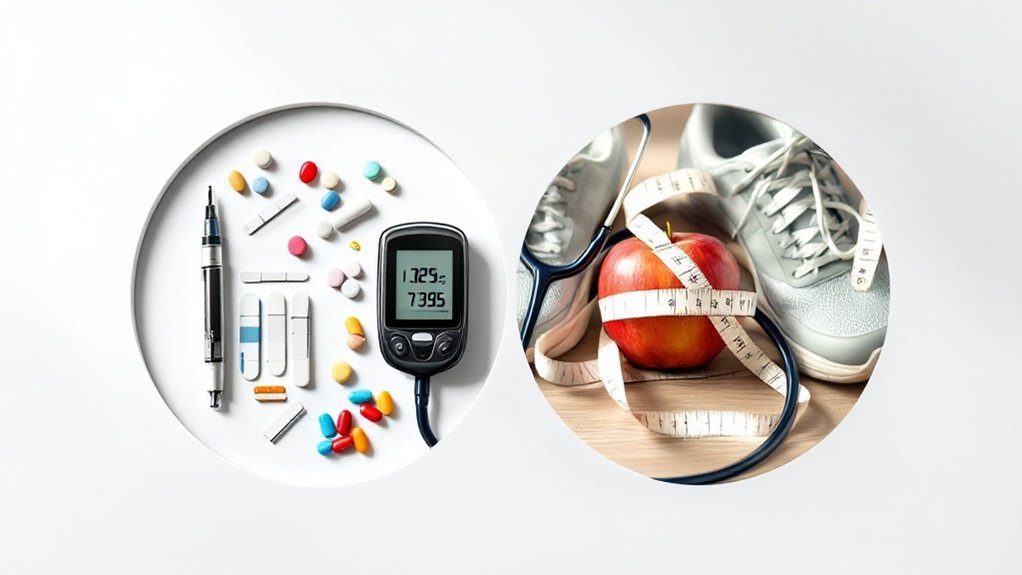Exercise is a blood sugar control powerhouse. Through regular physical activity, muscles become more sensitive to insulin and better at utilizing glucose – effects that can last up to 48 hours post-workout. A mix of aerobic exercises like jogging and resistance training delivers superior results, with just 150 minutes weekly making a significant impact. Timing matters too: working out 1-3 hours after meals helps stabilize levels. The path to metabolic mastery starts with understanding these fundamentals.

While many people struggle to control their blood sugar levels, exercise remains one of the most powerful – yet underutilized – tools for managing diabetes. It’s almost comical how something so simple can be so effective, yet many people would rather pop pills than break a sweat. The science is clear: regular physical activity dramatically improves insulin sensitivity and helps muscles gobble up glucose like hungry teenagers at a buffet.
The beauty of exercise lies in its versatility. Want to go for a swim? Perfect. Prefer lifting weights? That works too. The key is mixing it up – combining aerobic activities with resistance training for maximum impact. Those who combine both types of exercise achieve superior glycemic control compared to doing just one type of training. Starting with just 5-10 minute sessions allows beginners to build up their endurance safely. Regular exercise helps the pancreas maintain beta cell function for optimal insulin production.
Exercise is like a buffet – pick what you love, mix it up, and reap the rewards of both cardio and strength training.
And here’s the kicker: these benefits can last up to 48 hours after you’ve finished exercising. That’s right, your body keeps burning sugar long after you’ve showered and moved on with your day.
Timing matters, though. The sweet spot for exercise is typically one to three hours after eating, when blood sugar levels are riding high. Aim for 150 minutes of moderate-intensity exercise per week – that’s just 30 minutes, five days a week. Not exactly climbing Mount Everest, is it? But the results can be life-changing. Blood pressure drops, heart health improves, and those pesky blood sugar levels become more stable than a three-legged stool.
Smart exercisers know to monitor their blood sugar before and after workouts. High-intensity training can temporarily spike blood sugar levels – thanks, adrenaline! – so keeping fast-acting carbs nearby isn’t just smart, it’s essential. Think of it as your workout insurance policy.
The real magic happens when exercise becomes routine. Daily physical activity, consistent timing, and a mix of different exercises create a powerful trifecta for blood sugar control. It’s like having a built-in pharmacy that works 24/7, except this one doesn’t come with a copay or side effects warning label.
Just remember: your body was made to move, so use it or lose it.
Frequently Asked Questions
Can Certain Medications Affect Blood Sugar Levels During Exercise?
Medications absolutely affect blood sugar during exercise – sometimes dramatically.
Insulin and sulphonylureas are the big troublemakers, increasing hypoglycemia risk when working out.
Metformin can mess with heart rate and exercise performance. It’s a delicate dance.
Smart athletes check glucose levels religiously and keep glucose tablets handy.
Doctors need to know about exercise plans – better safe than sorry with diabetes meds.
What Are Signs of Dangerously Low Blood Sugar While Working Out?
Working out with dangerously low blood sugar isn’t pretty.
Early warning signs include sudden sweating, racing heartbeat, and anxiety – your body’s not-so-subtle hints that something’s wrong.
Things get serious fast: dizziness, confusion, and slurred speech mean trouble’s brewing. Some people even lose consciousness.
The scariest part? Regular exercisers might miss these signals entirely due to hypoglycemia unawareness.
Time to keep those glucose tabs handy.
Should I Eat Before or After Exercising to Maintain Blood Sugar?
The timing really depends on the individual and workout intensity. For most people, eating a light meal 2-3 hours before exercise works best.
But here’s the kicker – exercising right after meals actually helps control blood sugar better than working out on an empty stomach.
Post-workout eating is essential too, especially within 30 minutes.
And let’s be real – nobody wants to face a sugar crash mid-squat.
How Long Should I Wait After Meals Before Exercising?
Timing matters – big time.
For people without diabetes, wait about 15 minutes after eating before jumping into exercise. Diabetics need to hold off longer, roughly 30 minutes post-meal.
Why? Blood sugar peaks differently for everyone. Non-diabetics spike within 30-60 minutes of eating, while diabetics peak between 60-120 minutes.
Monitoring those levels is essential – nobody wants a dangerous sugar crash mid-workout.
Which Exercises Should Diabetics Avoid to Prevent Blood Sugar Complications?
Diabetics should steer clear of high-intensity workouts that trigger rapid blood sugar swings.
No breath-holding exercises or excessive weight lifting – they’re asking for trouble.
Contact sports? Think twice.
High-impact activities can wreck havoc on diabetic feet, while dehydrating exercises are a definite no-go.
And here’s a no-brainer: skip exercise entirely when ketones are present or during illness.
Safety first, folks.









